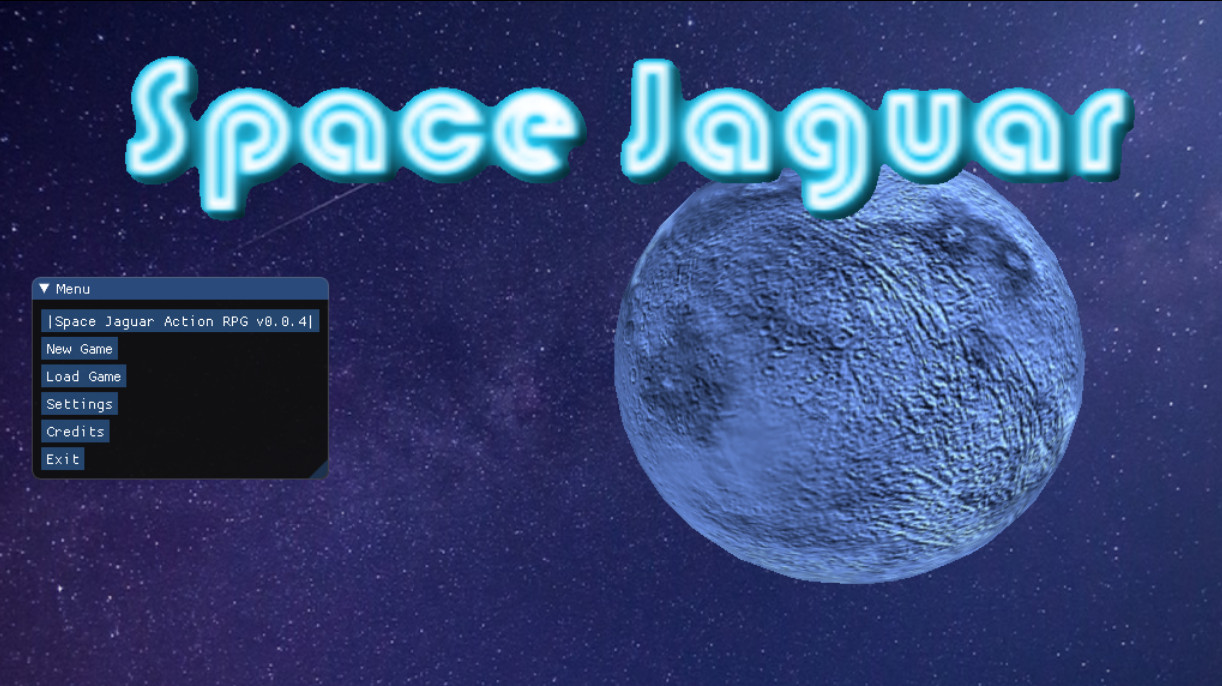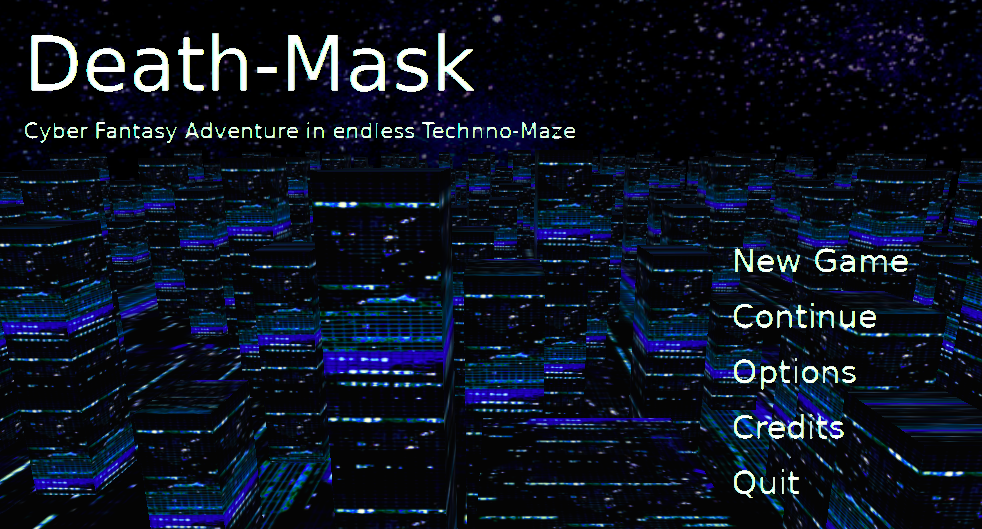I present to your attention Flame Steel Engine Runner – a platform for running multimedia applications based on the Flame Steel Engine toolkit. Supported platforms are Windows, MacOS, Linux, Android, iOS, HTML 5. The focus of application code development has shifted towards scripting – at the moment JavaScript support has been added using TinyJS, the toolkit itself and the engine will continue to be developed in languages close to hardware (C, C ++, Rust, etc.)

On the page below, you can spin the cube, write JavaScript code, upload models, sounds, music, code using the Upload files button, and start from the main.js file using the Run button.
https://demensdeum.com/demos/FlameSteelEngineRunner/
Category Archives: Demos
Space Jaguar Action RPG 0.0.4
First Space Jaguar Action RPG prototype for Webassembly:
Space Jaguar Action RPG – space pirate simulator. Features available right now:
- fly around
- die
- eat
- sleep
- recruit people
- look at unstoppable flow of time
Can’t walk in 3D scenes right now, due to bad optimization for web version. It will available in next versions.
Game engine source code, scripts are available under MIT license. All comments and feedback are welcome:
https://gitlab.com/demensdeum/space-jaguar-action-rpg
Linux version screenshots:



Write in C (ZX Spectrum) GameDev
This ne’er-do note is devoted to the development of games for the ZX Spectrum old computer to C. Let’s take a look at the handsome:
He began producing in 1982, and was produced until 1992. Technical data: 8-bit processor Z80, 16-128kb memory and other are extensions such as audio chipAY-3-8910.
The competition Yandex Retro Games Battle 2019 for this machine I wrote a game called Interceptor 2020. Since learning assembler for the Z80 did not have time, I decided to develop it in C language. As tulcheyna I chose the Quick Set – z88dk, which includes C compilers, and many support libraries to accelerate the implementation of applications for the Spectrum. It also supports many other Z80 machines, such as MSX, Texas Instruments calculators.
Next I will describe his flight over the surface computer architecture tulcheynom z88dk, show how it was possible to implement OOP approach is to use design patterns.
Special features
z88dk installation should be performed by a manual from the repository, but for Ubuntu users, I would like to mention feature – if you have already installed compilers for Z80 from the deb package, you should remove them as z88dk will default to access them from the bin folder of the -this version incompatibility tulcheyn compiler, you probably will not be able to collect anything.
Hello World
Write Hello World is very simple:
#include void main()
{
printf("Hello World");
}Assemble the tap in the file is even easier:
zcc +zx -lndos -create-app -o helloworld helloworld.c
To start using any emulator ZX Spectrum tap supporting files, such as Online:
Draw on the image to full screen
tl; dr Pictures drawn tiles, tiles 8×8 pixels size, the tiles themselves are embedded in the font Spectrum, then the string of index picture is printed.
O library sprites and tiles sp1 displays tiles using UDG. The picture is translated into a set of separate UDG (tiles) is then collected on the screen using the indices. It should be remembered that UDG is used to display the text, and if your image contains very large set of tiles (eg more than 128 tiles), you have to go beyond the set boundaries and to erase the default font Spectrum. To work around this limitation, I used a base of 128 – 255 using the simplified representation, leaving the original font on the spot. On simplification of the pictures below.
To draw a full-screen images you need to arm the three utilities:
Gimp
img2spec
png2c-z88dk
There is a way ZX real men, real retro warriors is to open the editing palette using Spectrum, especially knowing the output image, prepare it and manually unload using png2c-z88dk or png2scr.
Way easier – take a 32-bit image, switch to Gimp colors to 3-4, slightly to edit, then import into img2spec not to work by hand with color restrictions, export png and transferred to the C array with png2c-z88dk.
It should be remembered that successful export each tile can not contain more than two colors.
As a result, you get the h file that contains a number of unique tiles, if more than ~ 128, simplify the Gimp in a picture (increase repeatability) and spend on a new procedure for export.
After exporting, you literally download a “Font” from the tiles and typing “text” of the indices of tiles on the screen. Here is an example of the “class” of the rendering:
// loading font into memory
unsigned char *pt = fullscreenImage->tiles;
for (i = 0; i < fullscreenImage->tilesLength; i++, pt += 8) {
sp1_TileEntry(fullscreenImage->tilesBase + i, pt);
}
// set cursor into 0,0
sp1_SetPrintPos(&ps0, 0, 0);
// print string
sp1_PrintString(&ps0, fullscreenImage->ptiles);
Drawing sprites on the screen
Next, I will describe a way of drawing sprites of 16×16 pixels on the screen. Before the animation and change colors I came because corny at this stage, I guess I ran out of memory. Therefore, in the game there are only transparent monochrome sprites.
Draw in Gimp monochrome png image 16×16, etc. using png2sp1sprite translate it into assembly asm file in C code declare arrays of the assembly file, add the file at build time.
After the declaration of a resource of the sprite, it is necessary to add the screen to the desired position, then the sample code “class” game object:
struct sp1_ss *bubble_sprite = sp1_CreateSpr(SP1_DRAW_MASK2LB, SP1_TYPE_2BYTE, 3, 0, 0);
sp1_AddColSpr(bubble_sprite, SP1_DRAW_MASK2, SP1_TYPE_2BYTE, col2-col1, 0);
sp1_AddColSpr(bubble_sprite, SP1_DRAW_MASK2RB, SP1_TYPE_2BYTE, 0, 0);
sp1_IterateSprChar(bubble_sprite, initialiseColour);
From the names of some functions can understand the meaning – allotsiruem memory sprite, add two columns 8×8, add color for a sprite.
Each frame is affixed position of the sprite:
sp1_MoveSprPix(gameObject->gameObjectSprite, Renderer_fullScreenRect, gameObject->sprite_col, gameObject->x, gameObject->y);
OOP simulations
In C, there is no syntax for OOP, what do you do if you still really want to? It is necessary to connect the Dumka and illumined thought that such a thing as the PLO equipment does not exist, everything eventually comes to a machine architectures in which there is simply no concept of the object and other related abstractions.
This fact bothered me for a long time to understand why do you need the PLO, why you need to use it if in the end everything comes to machine code.
However, having worked in the product development, I opened the charm of this programming paradigms, primarily of course the development of the flexibility mechanisms of the protective code, with the right approach entropy reduction, simplification of teamwork. All of these advantages derive from the three pillars – polymorphism, encapsulation, inheritance.
Also worth noting is the simplification of addressing issues related to the architecture of the application, because 80% of architectural problems were solved by computer-scientists in the last century and described in the literature devoted to the design pattern. Next, I will describe how to add like OOP syntax in C.
For instance data storage more convenient to take the basis of class C structure. Of course, you can use a byte buffer to create its own structure for the classes, methods, but why reinvent the wheel? After all, we already reinventing syntax.
These classes
An example of the data fields “class” GameObject:
struct GameObjectStruct {
struct sp1_ss *gameObjectSprite;
unsigned char *sprite_col;
unsigned char x;
unsigned char y;
unsigned char referenceCount;
unsigned char beforeHideX;
unsigned char beforeHideY;
};
typedef struct GameObjectStruct GameObject;
We maintain our class as “GameObject.h” do #include “GameObject.h” in the right place and use.
Class methods
Take into service experience Objective-C language development, the signature method of the class will be from a function in the global osprey, the first argument will always transmitted data structure, method arguments go further. Next, an example of “the method” “class” GameObject:
void GameObject_hide(GameObject *gameObject) {
gameObject->beforeHideX = gameObject->x;
gameObject->beforeHideY = gameObject->y;
gameObject->y = 200;
}
Method call is as follows:
GameObject_hide(gameObject);
Constructors and destructors are implemented in the same manner. It can be implemented as an allocator constructor and field initializers, but I prefer separate methods for that,
Working with memory
Manual memory management type using malloc and free macros wrapped in new and delete operators for compliance with C ++:
#define new(X) (X*)malloc(sizeof(X))
#define delete(X) free(X)
For objects that are used by multiple classes at once, realized semi-manual memory management based on reference counting, in the image of the old mechanism of Objective-C Runtime ARC:
void GameObject_retain(GameObject *gameObject) {
gameObject->referenceCount++;
}
void GameObject_release(GameObject *gameObject) {
gameObject->referenceCount--;
if (gameObject->referenceCount < 1) { sp1_MoveSprAbs(gameObject->gameObjectSprite, &Renderer_fullScreenRect, NULL, 0, 34, 0, 0);
sp1_DeleteSpr(gameObject->gameObjectSprite);
delete(gameObject);
}
}
Thus, each class must declare the use of a common object using the retain, release the possession through release. In the modern version of ARC uses an automatic affixing call retain / release.
I sound!
Spectrum has a tweeter capable of reproducing 1-bit music, the composers of the time were able to play on it for up to 4 audio channels simultaneously. Spectrum 128k comprises a separate sound chip AY-3-8910, which can reproduce music tracker. To use the Tweeters in z88dk proposed library sound.h
What is to be learned
I was interested to read the Spectrum, to realize the game z88dk means, learn a lot of interesting things. I much remains to be explored, such as the assembler Z80, as it allows you to use the full power of Spectrum, the work of memory banks, working with the sound chip AY-3-8910. I hope to participate in the competition for next year!
References
https://rgb.yandex
https://vk.com/sinc_lair
https://www.z88dk.org/forum/
Source Code
https://gitlab.com/demensdeum/zx-projects/tree/master/interceptor2020
Death-Mask Wild Beta
Game Death-Mask goes into the status of a public beta (wild beta)
Reworked the main menu screen of the game, added a view of the blue zone of the techno-labyrinth, with pleasant music in the background.
Next, I plan to rework the gameplay controller, add smooth movement like in old shooters, high-quality 3D models of boxes, weapons, enemies, the ability to move to other levels of the techno-maze not only through portals (elevators, doors, fall through holes in the floor, holes in the walls), add a little variety to the environment of the generated maze. I will also work on the game balance.
Skeletal animation will be added at the polishing stage before release.
Death Mask Prototype Release
Video:
Death Mask Prototype for Windows:
http://demensdeum.com/games/deathMask/prototype/DeathMaskPrototype.exe
Linux and OS X users must compile Death Mask game from source:
https://github.com/demensdeum/Death-Mask
Right now I am going to add gameplay elements, lights, animations to the engine.
WebGL + SDL + Emscripten
В итоге я портировал Мику на WebGL, с помощью SDL 1 и Emscripten.
Дальше я опишу что нужно было изменить в коде чтобы сборка в JavaScript завершилась успешно.
- Использовать SDL 1 вместо SDL 2. На данный момент существует порт SDL 2 для emscripten, однако использовать встроенный в emscripten SDL 1 я посчитал более целесобразным. Инициализация контекста происходит не в окне, а с помощью SDL_SetVideoMode и флага SDL_OPENGL. Отрисовка буфера производится командой SDL_GL_SwapBuffers()
- Из-за особенностей выполения циклов в JavaScript – рендеринг вынесен в отдельную функцию и его периодический вызов проставляется с помощью функции emscripten_set_main_loop
- Также сборку нужно осуществлять с ключом “-s FULL_ES2=1“
- Пришлось отказаться от библиотеки assimp, от загрузки модели из файловой системы, от загрузки текстуры с диска. Все необходимые буферы были прогружены на деcктоп версии, и прокинуты в c-header файл для сборки с помощью emscripten.
Статьи:
http://blog.scottlogic.com/2014/03/12/native-code-emscripten-webgl-simmer-gently.html
https://kripken.github.io/emscripten-site/docs/porting/multimedia_and_graphics/OpenGL-support.html
Модель:
https://sketchfab.com/models/7310aaeb8370428e966bdcff414273e7
Bad Robots WebGL by ThreeJS
Today I released Bad Robots game with experimental WebGL Renderer based on ThreeJS.
This is first OpenGL (WebGL) based game on Flame Steel Engine.
You can play it here:
http://demensdeum.com/games/BadRobotsGL/
ThreeJS based IOSystem source code is available here:
https://github.com/demensdeum/FlameSteelEngineGameToolkitWeb
Bad Robots – HTML 5 Game
First game on Flame Steel Engine.
http://demensdeum.com/games/BadRobots/BadRobots.html
Shoot all robots on the screen!
Credits:
Robot sprite – http://opengameart.org/content/xeon-ultimate-smash-friends
Music – Killers Kevin MacLeod (incompetech.com)
Source code:
https://gitlab.com/demensdeum/BadRobots
https://gitlab.com/demensdeum/FlameSteelEngine
https://gitlab.com/demensdeum/FlameSteelEngineGameToolkit




